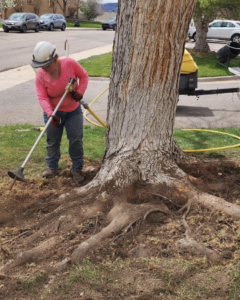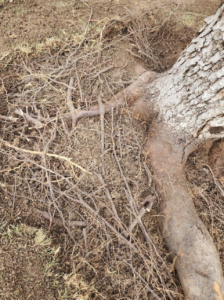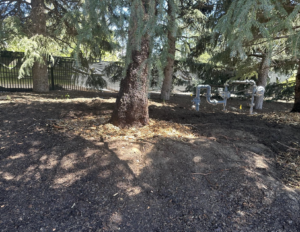Air Spading Service in Denver
If you’ve recently heard about air spading, but you’re still feeling uncertain about the service, give us a call. We’ll gladly help you walk through the best available options for your tree and your yard. We have multiple multiple ISA-certified arborists on staff, plus multiple other college degrees, which means we’re the most educated and experts in Denver with the air spading technique.
I Can’t Feel My Roots!
The roots of a tree provide the plant with a variety of functions. Water and nutrient uptake, anchorage, oxygen uptake, production of a hormone that promotes canopy growth, storage of photosynthesis (along with the woody tissues).
Disruption of root functions and activities reduces all necessary functions for trees, which in turn affects over all plant health. Additionally, planting depth, root, soil (soil type and compaction), and water issues also cause interference and exacerbates root conditions.
With our clay soil girdling roots are very common. It is also common with certain species of trees but is common just due to some of our prevalent soil profile types. It can also be due to the way a tree is grown. Some of our larger trees, girdling roots are visible, but most oftentimes girdling trees stem girdling roots are not visible, as they are hidden below ground. At Bailey Tree we pride ourselves in our continual innovation of new service offerings to maintain overall plant health and longevity.
One of our newer offerings is tree air spading. This service is for trees with heavy clay and/or soil compaction. Sometimes with these trees we can see visible girdling roots at the surface, and usually there are many more below the surface. While we can’t remove all of them, we selectively remove the worst culprits.
How Does Air Spading Work?
Air Spading involves the process of removing the turfgrass, or surrounding landscaped area (the diameter is determined by the assessing arborist) with the air spade or by hand. Once the turfgrass or surrounding landscaping is removed the process continues with the air spade (which consists of compressed air forced through a hollow metal tube of sorts) to excavate root flares, transport/anchor roots, fibrous root hairs, and girdling roots while breaking up clay soil. In an ideal situation the soil is in a moist state.
Once we have completed the removal of the identified girdling roots and abated the compaction of the soil we start incorporating a composted soil mixture, mycorrhizae-a beneficial soil fungus for the tree), and an organic fertilization product. After this process we then spread wood chips over the air spaded area.
The reason we utilize wood chip vs. bark mulch, is to reduce the depletion of nitrogen in the soil. Bark has a large sequestration of lignin (what makes wood, wood) and it draws nitrogen out of the soil. The other reason is that wood chip breaks down quicker and will provide additional organic matter to the tree to help feed the soil organisms that in turn assist in feeding the tree.
Here are some photos of how air spading appears once completed in a Silver Maple (left) and a Spruce (right). Call today to receive start your free estimate!



